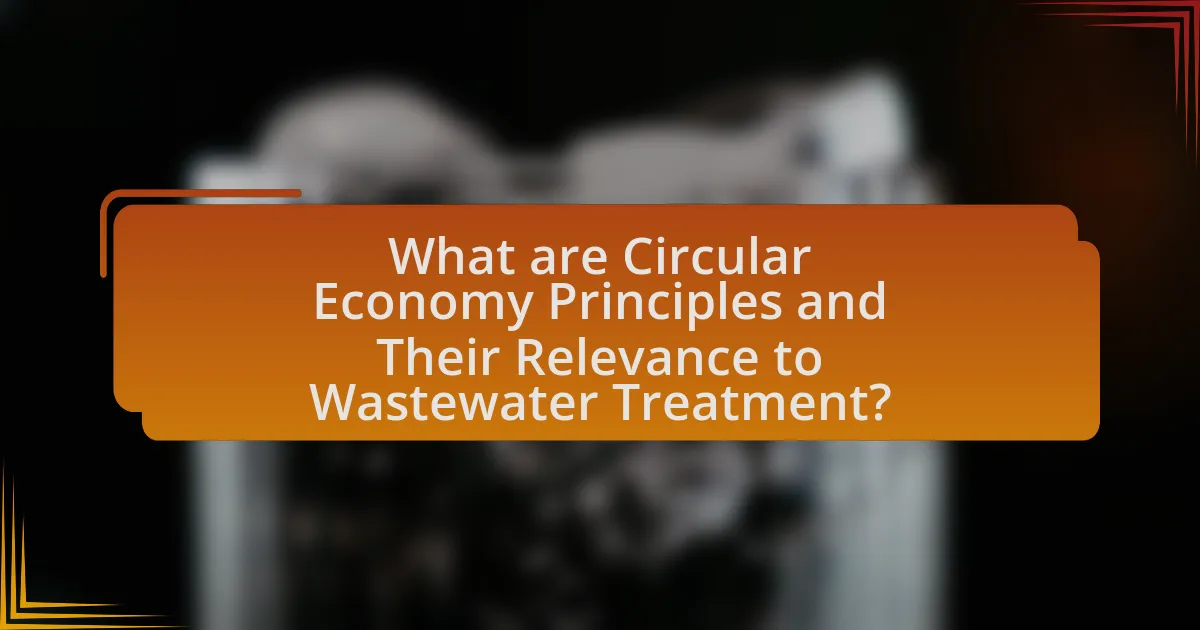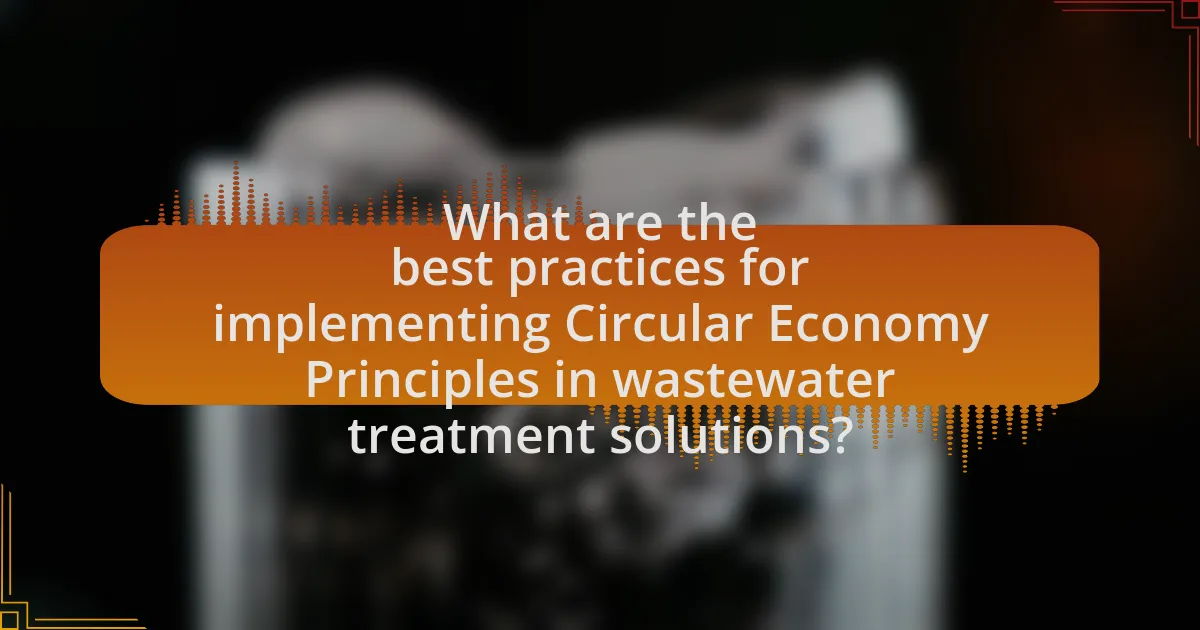The article focuses on the impact of Circular Economy Principles on wastewater treatment solutions, emphasizing the transformation of wastewater from a disposal issue into a valuable resource. It outlines key components such as resource recovery, waste minimization, and system efficiency, highlighting innovative technologies like anaerobic digestion and membrane bioreactors that enhance sustainability. The article also addresses the financial implications, environmental benefits, and challenges faced by wastewater treatment facilities in adopting these principles, while providing best practices and performance indicators for successful implementation. Overall, it underscores the importance of integrating circular economy strategies to improve resource efficiency and reduce environmental impacts in wastewater management.
What are Circular Economy Principles and Their Relevance to Wastewater Treatment?

Circular economy principles focus on minimizing waste and maximizing resource efficiency through practices such as recycling, reusing, and recovering materials. In the context of wastewater treatment, these principles are relevant as they promote the transformation of wastewater from a disposal challenge into a resource, enabling the recovery of water, nutrients, and energy. For instance, technologies like anaerobic digestion can convert organic waste in wastewater into biogas, which can be used for energy production, thereby reducing reliance on fossil fuels. Additionally, nutrient recovery processes can extract phosphorus and nitrogen from wastewater, which can be reused in agriculture, thus closing the nutrient loop. This approach not only enhances sustainability but also reduces environmental impacts associated with traditional wastewater treatment methods.
How do Circular Economy Principles redefine traditional wastewater treatment approaches?
Circular economy principles redefine traditional wastewater treatment approaches by emphasizing resource recovery and minimizing waste. This shift transforms wastewater from a disposal problem into a valuable resource, promoting the extraction of nutrients, energy, and water for reuse. For instance, technologies such as anaerobic digestion and membrane bioreactors facilitate the recovery of biogas and treated water, respectively, which can be repurposed for agricultural or industrial use. Research indicates that implementing circular economy strategies in wastewater management can reduce operational costs and environmental impacts, as seen in case studies where facilities achieved up to 80% resource recovery.
What are the key components of Circular Economy Principles in the context of wastewater treatment?
The key components of Circular Economy Principles in the context of wastewater treatment include resource recovery, waste minimization, and system efficiency. Resource recovery focuses on extracting valuable materials such as nutrients, water, and energy from wastewater, thereby reducing the need for virgin resources. Waste minimization emphasizes reducing the volume and toxicity of wastewater generated, which can be achieved through improved processes and technologies. System efficiency involves optimizing the entire wastewater treatment process to enhance performance and reduce energy consumption, contributing to sustainability. These components collectively support a more sustainable approach to wastewater management, aligning with the goals of a circular economy.
Why is it important to integrate these principles into wastewater management?
Integrating circular economy principles into wastewater management is crucial for enhancing resource efficiency and sustainability. These principles promote the recovery and reuse of water and nutrients, reducing environmental impact and conserving natural resources. For instance, implementing technologies that extract phosphorus from wastewater can significantly decrease reliance on mined phosphorus, which is a finite resource. Additionally, the circular economy approach can lead to cost savings; a study by the Ellen MacArthur Foundation highlights that transitioning to circular practices in water management can save up to $1 trillion globally by 2030. Thus, integrating these principles not only addresses environmental concerns but also fosters economic benefits and resource sustainability.
What challenges do wastewater treatment facilities face in adopting Circular Economy Principles?
Wastewater treatment facilities face significant challenges in adopting Circular Economy Principles, primarily due to financial constraints, technological limitations, and regulatory hurdles. Financially, the initial investment required for advanced technologies and infrastructure modifications can be prohibitive, as many facilities operate on tight budgets. Technologically, existing systems may not be compatible with circular practices, necessitating costly upgrades or replacements. Additionally, regulatory frameworks often lag behind innovative practices, creating barriers to implementation and discouraging facilities from pursuing circular approaches. These challenges collectively hinder the transition towards more sustainable wastewater management practices.
How can existing infrastructure adapt to support these principles?
Existing infrastructure can adapt to support circular economy principles in wastewater treatment by integrating resource recovery technologies and optimizing processes for efficiency. For instance, facilities can implement anaerobic digestion systems to convert organic waste into biogas, which can be used for energy production, thereby reducing reliance on fossil fuels. Additionally, existing treatment plants can upgrade to advanced filtration and membrane technologies that enable the recovery of nutrients like nitrogen and phosphorus, which can be reused in agriculture. These adaptations not only enhance sustainability but also align with the principles of reducing waste and maximizing resource use, as evidenced by case studies showing that facilities adopting such technologies have significantly decreased their environmental impact while improving operational efficiency.
What are the financial implications of transitioning to a circular economy model?
Transitioning to a circular economy model can lead to significant financial implications, including cost savings, increased revenue opportunities, and reduced resource dependency. Companies adopting circular practices often experience lower operational costs due to decreased waste generation and improved resource efficiency. For instance, a study by the Ellen MacArthur Foundation found that transitioning to a circular economy could generate $4.5 trillion in economic benefits by 2030, highlighting the potential for substantial financial gains. Additionally, businesses can tap into new markets by offering recycled materials and services, further enhancing their revenue streams. Overall, the financial implications of this transition are largely positive, driven by efficiency improvements and new business opportunities.
How do Circular Economy Principles enhance the efficiency of wastewater treatment solutions?

Circular Economy Principles enhance the efficiency of wastewater treatment solutions by promoting resource recovery and minimizing waste. These principles encourage the reuse of treated water and the extraction of valuable by-products, such as nutrients and energy, which can significantly reduce operational costs and environmental impact. For instance, implementing anaerobic digestion in wastewater treatment can convert organic matter into biogas, providing a renewable energy source while reducing sludge volume. This approach not only improves the sustainability of the treatment process but also aligns with the goals of reducing resource consumption and enhancing overall system efficiency.
What innovative technologies are emerging from the application of Circular Economy Principles?
Innovative technologies emerging from the application of Circular Economy Principles include advanced wastewater treatment systems that utilize resource recovery methods. These systems, such as membrane bioreactors and anaerobic digestion, enable the extraction of valuable resources like biogas and nutrients from wastewater, thereby reducing waste and promoting sustainability. For instance, the implementation of anaerobic digestion can convert organic waste into biogas, which can be used for energy production, demonstrating a practical application of circular economy principles in wastewater management.
How do these technologies improve resource recovery in wastewater treatment?
Technologies such as anaerobic digestion, membrane bioreactors, and advanced oxidation processes significantly enhance resource recovery in wastewater treatment by efficiently converting organic matter into biogas, reclaiming water, and recovering nutrients. Anaerobic digestion allows for the breakdown of organic waste, producing biogas that can be used as renewable energy, while membrane bioreactors improve the separation of solids and liquids, leading to higher quality effluent and the potential for water reuse. Advanced oxidation processes facilitate the removal of contaminants, enabling the recovery of valuable resources like phosphorus and nitrogen, which can be repurposed as fertilizers. These technologies collectively contribute to a more sustainable approach to wastewater management, aligning with circular economy principles by minimizing waste and maximizing resource utilization.
What role does data management play in optimizing wastewater treatment processes?
Data management plays a critical role in optimizing wastewater treatment processes by enabling real-time monitoring and analysis of operational data. Effective data management systems facilitate the collection, storage, and processing of data from various sources, such as sensors and treatment equipment, which allows for informed decision-making and process adjustments. For instance, utilizing data analytics can lead to improved efficiency in chemical dosing and energy consumption, ultimately enhancing the overall performance of treatment facilities. Studies have shown that facilities employing advanced data management techniques can achieve up to a 30% reduction in operational costs while maintaining compliance with environmental regulations.
What are the environmental benefits of implementing Circular Economy Principles in wastewater treatment?
Implementing Circular Economy Principles in wastewater treatment significantly reduces environmental impacts by promoting resource recovery and minimizing waste. This approach enables the extraction of valuable materials, such as nutrients and energy, from wastewater, thereby decreasing reliance on virgin resources and reducing pollution. For instance, the European Commission’s Circular Economy Action Plan highlights that recovering phosphorus from wastewater can reduce the need for mining, which is environmentally damaging. Additionally, utilizing biogas generated during treatment processes can lower greenhouse gas emissions by providing a renewable energy source. Overall, these principles foster a sustainable cycle that enhances ecosystem health and conserves natural resources.
How does resource recovery contribute to sustainability goals?
Resource recovery significantly contributes to sustainability goals by minimizing waste and promoting the reuse of materials. This process reduces the demand for virgin resources, thereby lowering environmental degradation and conserving natural ecosystems. For instance, recovering nutrients from wastewater can lead to the production of fertilizers, which decreases reliance on synthetic alternatives that often harm the environment. Additionally, the global market for resource recovery is projected to grow, with estimates suggesting it could reach $1 trillion by 2025, highlighting its economic viability alongside environmental benefits.
What impact does reduced waste generation have on local ecosystems?
Reduced waste generation positively impacts local ecosystems by decreasing pollution and conserving natural resources. When less waste is produced, there is a lower likelihood of harmful substances entering soil and water systems, which helps maintain biodiversity and ecosystem health. For instance, studies show that reduced plastic waste leads to fewer microplastics in aquatic environments, benefiting marine life and preserving food chains. Additionally, less waste generation encourages sustainable practices, such as recycling and composting, which further enhance soil quality and promote plant growth, thereby supporting local wildlife habitats.
What are the best practices for implementing Circular Economy Principles in wastewater treatment solutions?

The best practices for implementing Circular Economy Principles in wastewater treatment solutions include resource recovery, energy efficiency, and stakeholder engagement. Resource recovery involves extracting valuable materials such as nutrients and water from wastewater, which can be reused in agriculture or industrial processes, thereby reducing waste and promoting sustainability. Energy efficiency can be achieved through the use of advanced technologies like anaerobic digestion, which not only treats wastewater but also generates biogas that can be used as a renewable energy source. Stakeholder engagement is crucial for ensuring that the community and industries understand and support circular practices, leading to better implementation and acceptance of these solutions. These practices are supported by studies indicating that integrating circular economy principles can significantly enhance the sustainability and efficiency of wastewater treatment systems.
How can stakeholders collaborate to promote circular practices in wastewater management?
Stakeholders can collaborate to promote circular practices in wastewater management by establishing partnerships that integrate resource recovery, technology sharing, and regulatory frameworks. Collaborative efforts can include municipalities, industries, and research institutions working together to implement innovative treatment technologies that recover valuable resources such as nutrients and energy from wastewater. For instance, the European Union’s Circular Economy Action Plan emphasizes the importance of multi-stakeholder engagement to enhance resource efficiency and reduce waste, demonstrating that effective collaboration can lead to sustainable wastewater management solutions.
What role do policy frameworks play in facilitating this transition?
Policy frameworks play a crucial role in facilitating the transition to circular economy principles in wastewater treatment solutions by establishing regulations and incentives that promote sustainable practices. These frameworks guide stakeholders, including governments and industries, in implementing strategies that minimize waste and enhance resource recovery. For instance, the European Union’s Circular Economy Action Plan outlines specific targets for water reuse and nutrient recovery, encouraging member states to adopt innovative technologies and practices. This regulatory support not only drives investment in sustainable infrastructure but also fosters collaboration among various sectors, ultimately leading to improved environmental outcomes and economic benefits.
How can community engagement enhance the effectiveness of circular initiatives?
Community engagement enhances the effectiveness of circular initiatives by fostering collaboration and increasing local participation in sustainability efforts. Engaged communities are more likely to adopt circular practices, such as recycling and resource sharing, which directly contribute to reducing waste and promoting efficient resource use. Research indicates that initiatives with strong community involvement can achieve up to 30% higher participation rates in recycling programs, as seen in case studies from cities implementing community-led waste management strategies. This active participation not only improves the success of circular initiatives but also builds a sense of ownership and responsibility among community members, leading to long-term behavioral changes that support circular economy principles.
What practical steps can wastewater treatment facilities take to adopt Circular Economy Principles?
Wastewater treatment facilities can adopt Circular Economy Principles by implementing resource recovery systems that convert waste into valuable products. These systems can include technologies for extracting nutrients like nitrogen and phosphorus, which can be reused as fertilizers, thereby reducing reliance on synthetic alternatives. Additionally, facilities can invest in anaerobic digestion processes to generate biogas, which can be used for energy production, thus minimizing energy consumption from external sources.
Moreover, integrating water reuse strategies, such as treating wastewater for irrigation or industrial processes, can significantly decrease freshwater demand. According to the International Water Association, adopting these practices not only enhances sustainability but also improves operational efficiency and reduces costs associated with waste disposal and resource procurement.
What are the key performance indicators to measure success in this transition?
Key performance indicators (KPIs) to measure success in the transition to circular economy principles in wastewater treatment include resource recovery rates, energy efficiency, operational cost savings, and reduction in waste generation. Resource recovery rates quantify the amount of nutrients, water, and energy reclaimed from wastewater, indicating the effectiveness of circular practices. Energy efficiency measures the energy consumption relative to the volume of wastewater treated, reflecting improvements in sustainability. Operational cost savings assess the financial benefits derived from implementing circular economy strategies, while reduction in waste generation tracks the decrease in byproducts produced during treatment processes. These KPIs provide a comprehensive framework for evaluating the effectiveness of transitioning to circular economy principles in wastewater treatment solutions.
How can facilities ensure continuous improvement in their circular economy practices?
Facilities can ensure continuous improvement in their circular economy practices by implementing regular assessments and adopting innovative technologies. Regular assessments allow facilities to evaluate their current practices, identify inefficiencies, and set measurable goals for waste reduction and resource recovery. For instance, a study by the Ellen MacArthur Foundation highlights that organizations that conduct annual reviews of their circular economy strategies can achieve up to 30% improvement in resource efficiency over five years. Additionally, adopting innovative technologies, such as advanced wastewater treatment systems, can enhance resource recovery and minimize waste generation, further supporting continuous improvement.


